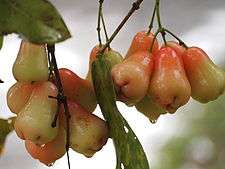Syzygium aqueum
| Syzygium aqueum | |
|---|---|
 | |
| Rare (NCA) | |
| Scientific classification | |
| Kingdom: | Plantae |
| (unranked): | Angiosperms |
| (unranked): | Eudicots |
| (unranked): | Rosids |
| Order: | Myrtales |
| Family: | Myrtaceae |
| Genus: | Syzygium |
| Species: | S. aqueum |
| Binomial name | |
| Syzygium aqueum Alston | |
| Synonyms[1] | |
| |

Syzygium aqueum is a species of brush cherry tree. Its common names include water cherry, watery rose apple, and lau lau; names like "water apple" and "bell fruit" may refer to any species of Syzygium grown for its fruit. In Indonesia and Malay, it is known as jambu air meaning "water guava". In Bengali language, the fruit is called GolapJaam. The tree is cultivated for its wood and edible fruit. The fruit is a fleshy yellow or red berry which is bell shaped, waxy and crisp. Syzygium aqueum is sold in Indonesia and Papua New Guinea. The tree requires heavy rainfalls and can survive in tropical habitats, up to 1600m from sea level.[2] The wood is hard and can be used to make tools. The bark of the tree is sometimes used in herbal medicines. It is grown in orchards and gardens and parks as an ornamental plant. The leaves are edible and are sometimes used to wrap food.
The fruit has a very mild and slightly sweet taste similar to apples, and a crisp watery texture like the inside of a watermelon. It is a staple of Southeast Asian fruit stands, where it is inexpensive while in season. It does not bruise easily and may be preserved for months in a household refrigerator.
References
- ↑ "The Plant List: A Working List of All Plant Species".
- ↑ [French, Bruce R. 1989. Food plants of Papua New Guinea : a compendium.].